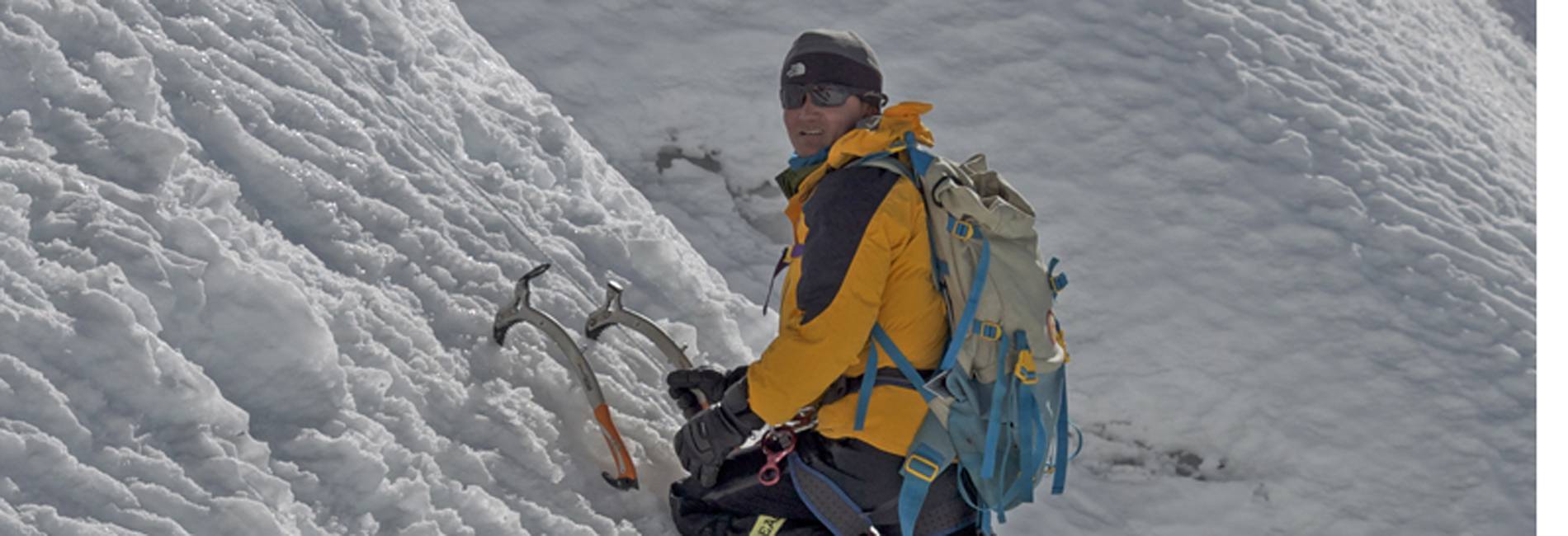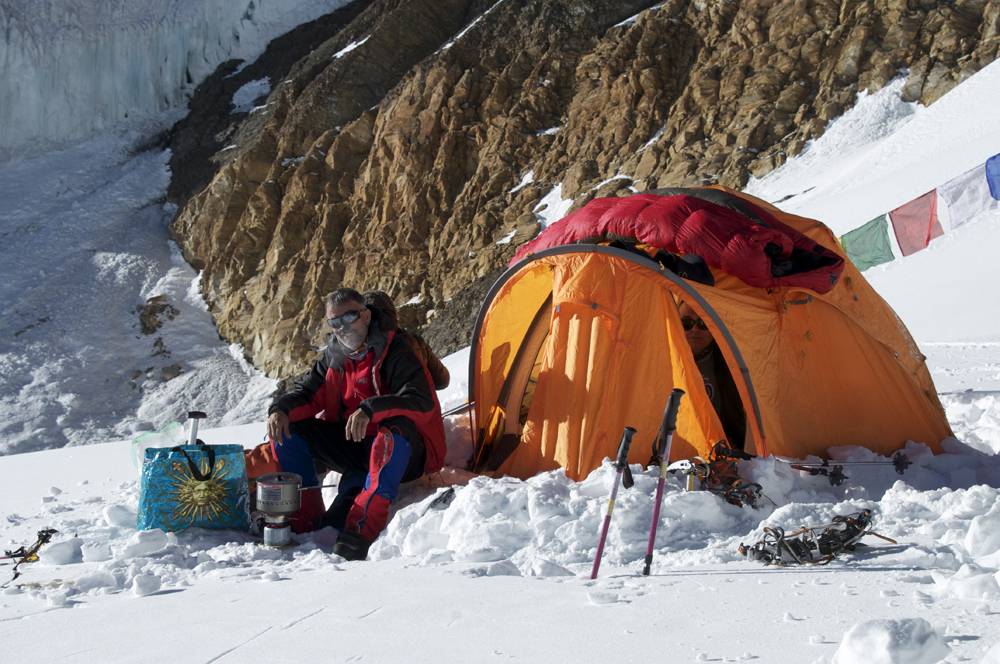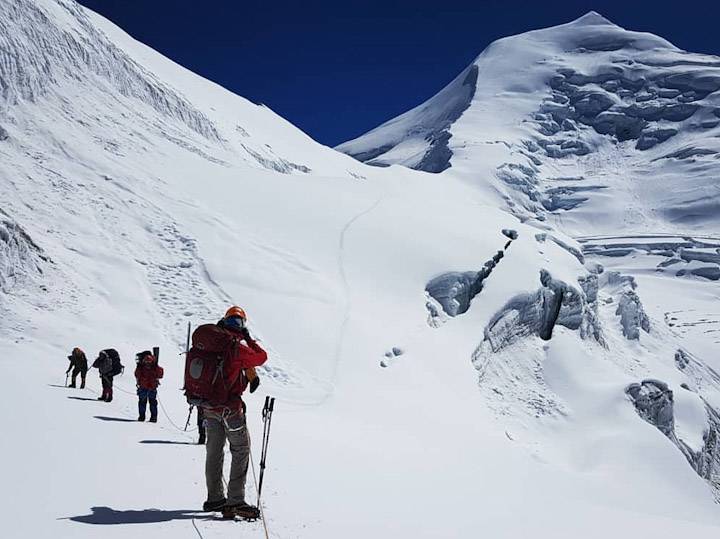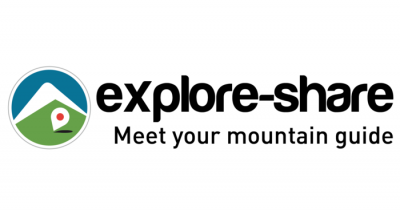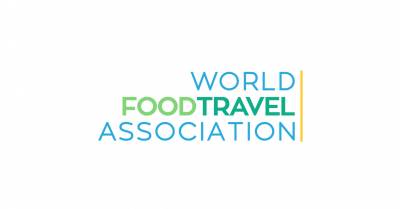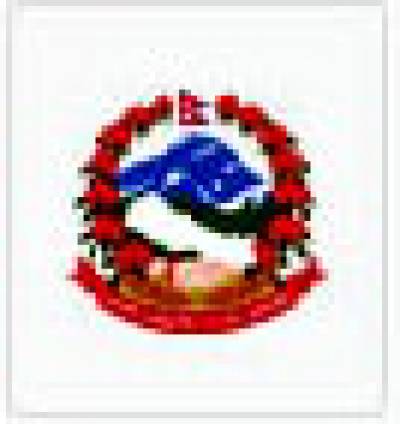HIMLUNG HIMAL EXPEDITION ( 7,126 M )
Go the extra mile and make a highly recommended detour off the usual path to this rarely visited purely Tibetan influenced region steeped in Buddhism. Himlung Himal (7126m) is in the Manaslu region of Nepal wedged between the Annapurna Range and Manaslu Range, close to the Tibetan border in a very far-flung western region of Nepal. This mountain is an excellent warm-up for those wanting to go higher, but in itself will give you all the thrills of a true mountain climbing expedition. You will be within the Manaslu Conservation Area and will be well away from the more hectic Annapurna trail with your base just above the Tibetan village of Phu Gaon (4250m) in the very isolated and restricted Nar-Phu region of Nepal. There are no roads into this region and the only way to get in goods is by yak, mule, or carried by porters. At these altitudes, you will find yaks grazing and an abundance of Tibetan prayer flags
It is a relatively straight forward climb to the peak, however, you will need to be a fit and experienced mountain climber in order to reach the summit and endure the high altitude. Himlung Himal was first climbed in 1992 putting it on the map as a climbing destination.
Prior to arriving at base camp, you will trek alongside the Phu River in the serene Phu Valley passing through distinctly Tibetan Buddhist villages oozing with culture and history. Leaving Kathmandu we drive to Bhulbhule (840m) and then put on our boots and start trekking to the villages of Jagat (1300m), Dharapani (1860m), Koto (2670m), Meta (3650m), Phu Gaon (4250m- largest Tibetan settlement in the region), and on to Himlung Base Camp (4850m) that will be home for the climbing period of around 14 days. From here we will begin our preparation and practice over and over the methods, we will utilize to reach the summit, including taking it in steps to reach the higher camps. We will leave nothing to chance. We have allowed enough extra days at these camps to wait out poorer weather conditions or for some to adjust to the altitudes. We will establish three higher camps at 5450m, 6000m, and 6250m, where we can spend time acclimatizing.
After successfully climbing the Peak we will head back down to Meta(3650m), Koto (2600m), Syange (1100m), Besisahar – by jeep (760m), and return to Kathmandu by private vehicle or local bus.
The ideal time to make this climb is in March, April, or October and November when the snow is still compacted thus making it safer and easier to traverse.
Sherpa Expedition and Trekking take care of everything from permits, fees, and all accommodation along the trail. Your safety and enjoyment are always our main concern. With more than 40 years in the trekking and climbing business, we understand the difference between a good experience and a great experience. Our reputation speaks for itself.
ITINERARY
Day 1 : Arrival in Kathmandu and transfer to hotel.
Day 2 : Sightseeing of the UNESCO heritage sites in Kathmandu
Day 3 : Kathmandu to Bhulbule (840m), 6-7 hrs drive / Lodge
Day 4 : Bhulbule to Jagat (1300m), 5-6 hrs / Lodge
Day 5 : Jagat to Dharapani (1860m), 5-6 hrs / Lodge
Day 6 : Dharapani to Koto (2670m), 5-6 hrs
Day 7 : Chame to Meta (3650m), 7-8 hrs / Campsite
Day 8 : Meta to Phu (4400m), 5-6 hrs / Campsite
Day 9 : Phu to Himlung Base Camp (4850m), 4-5 hrs / Campsite
Day 10 - 23 : Acclimatization and climbing period (14 days)
Day 24 : Base Camp to Meta(3650m), 6-7 hrs / Campsite
Day 25 : Meta to Koto (2600m), 6-7 hrs / Lodge
Day 26 : Koto to Syange (1100m), 5-6 hrs (by jeep) / Lodge
Day 27 : Syange to Besisahar (760m), 4-5 hrs (by jeep) / Lodge
Day 28 : Besisahar to Kathmandu (1350m), 6-7 hrs (by private car)
Day 29 : Leisure day in Kathmandu
Day 30 : Departure international flight
SERVICES
EXPEDITION COST INCLUDES:
- All airport pick up drop by private vehicles
- 4 nights hotel (3-stars) in Kathmandu, B/B plan
- Expedition Royalty and permit from Nepal government to climb Mt. Himlung.
- 25 kg weight per Sherpa climber is allowed for expedition
- Necessary Sherpa porters or mules for carrying equipment & loads
- Twin sharing accommodation in available lodge/teahouse while trekking
- 3 times meals per day, (Breakfast, Lunch, and dinner) teas & coffees in trekking & during the camping period.
- Common climbing gears like necessary rope, ice bars, ice screws, etc
- Twin sharing tent of North face brand or similar for Base Camp
- Experienced and government licensed trekking and climbing Sherpa guide during the trekking and climbing period.
- All food and fuel for base camp and higher camps during the climbing period.
- Trekking Permit (Narphu and Annapurna Conservation Park entry fee).
- Kitchen, Dining, Store tent, mattress and all camping facilities needed in Base Camp.
- The experienced and professional Sherpa staff at Base Camp: Base camp manager, cook, kitchen Boy.
- Government liaisons officer
- Equipment medical & life, allowance, wages, life, medical & rescue insurance for all Nepali members.
- Emergency oxygen bottle, mask & regulator at ABC (Use and pay)
- Immediate Rescue co-ordination (covered by your personal travel insurance)
- Generator or solar panel for charging & lighting in Himlung Himal Base camp
- Satellite phone on pay call basis (1 min: $4)
- Welcome Dinner at typical Nepali Restaurant in Kathmandu
- Our service charge
EXPEDITION COST EXCLUDES:
- International flight fare, taxes, and visas (visa charge USD 40 and 4 passport photographs for the visa).
- Lunch and dinner in Kathmandu and Pokhara
- Nepal entry visa fee (easy to obtain the visa on arrival at Tribhuvan International Airport – Kathmandu). $30 USD for 15-day, $50 USD for 30 Days, and $125 USD for 90 Days visa.
- Your Personal trekking & climbing equipment
- Excess baggage transport
- All expenses of personal nature like Wifi, Hot Shower, bar bills, laundry, telephone, etc.
- Travel insurance for accident, medical, emergency evacuation & lost baggage.
- Applicable permit fee & custom fee for satellite phone, filming camera, communications - equipment (if brought)
- Climbing Bonus & summit bonus for climbing Sherpa (if you use Sherpa), Tips for Base Camp Staff and Climbing guide. Summit bonus $500.00USD minimum for each climbing Sherpa guide.
EQUIPMENTS
Travel Documents
- Valid Passport
- Credit Cards
- Pp Size Photo (4 Pieces)
- Insurance Paper And Contact Address.
- Family Members / Company’s Contact Address
Foot Wear
- Kailas / Lasportiva / Millet (Summit Shoe)
- Normal Socks (5-6 Pairs)
- Summit Socks (2 Pairs)
- Trekking Shoes (1 Pair)
- Camp Booties (1 Pair)
- Basecamp Slipper (1 Pair)
Upper Body
- Light Weight Top / Thermo Coat (2-3 Layers)
- Mid Weight Top (2-3 Layers)
- Heavy Weight Top (2 Layers)
- Fleece Jacket (1)
- Gore Text Jacket (1)
- Down Jacket (1)
- Wind Proof Jacket
- Cotton T-Shirt For Base Camp. (2-3)
Lower Body
- Light Weight Long Under Pants (2-3 Pairs)
- Under Wear (5-7 Pairs)
- Mid Weight Long Under Pants (2-3 Pairs)
- Heavy Weight Long Under Wear
- Gore Text Pant. (1)
- Down Pants. (1)
- Water Proof Pant. (1)
Head
- Sun Cap
- Desert Cap
- Balaclava
- Fleece Hat
- Neck Gaiter (2-3)
Hands
- Thin Fleece Gloves (2 Pairs)
- Wind Stopper Fleece Gloves
- Heavy Gloves (Mitten)
- Summit Gloves
Sleeping Bags
- Sleeping Bag - 20 Degree Celsius (For Base Camp)
- Down Sleeping Bag - 20 To -40 Degree Celsius (Extreme Comfort)
- Thermarest Mattress (Cell Foam)
- Thermarest Mattress (Inflatable)
Climbing Equipment
- Climbing Helmet
- Down Suit (Kailas / Marmot / Mountain
- Hardware / North Face / Millet )
- Crampons (Fit with Boot)
- Ice Axe
- Harness
- Atc Guide
- Jummer / Ascender
- Lock Carabiner (3)
- Unlock Carabiner (3)
- Tape Slings (2)
- Prusik Loops (1)
- Snow Goggle
- Head Light (4 Pairs Rechargeable Batteries Recommended)
- Satellite Phone
- Hand Warmer (If Possible)
Bag Packs
- Rucksacks 45L - 55L
- Duffle Bag 90 L -120 L (2 Pieces)
- Water Proof Stuff Sacks Large (2 Pieces)
- Water Proof Stuff Sacks Small (2 Pieces)
Sun Stuffs
- Banana Boat/ Nivea Sun Cream -50 (Spf)
- Lip Guard -20 / -50 (Spf)
- Sun Glasses (UV Protection)
- Glaciers Glasses (UV Protection)
Toiletries
- Hand Disinfectant
- Wet Tissue
- Toothpaste
- Toothbrush
- Soap
- Shampoo
- Garbage Bag
Eating & Drinking
- Water Bottle (2)
- Thermos
- Mug
- Spoon/ Fork
- Bowl
Medical
- Brufen / Ibuprofens
- Antibiotic
- Diamox
- Paracetamol
- Handy Plaster
- Crack Bandage
- Tincture Iodine
Miscellaneous
- Walking Stick
- Pocket Knife (Swiss)
- Umbrella / Rain Coat
GOOD TO KNOW
The Himlung Himal Expedition is a challenging and rewarding mountaineering adventure in the remote region of Nepal. Himlung Himal, standing at an impressive height of 7,126 meters (23,379 feet), offers breathtaking views and an opportunity to experience the beauty of the Himalayas. Here are all the details you need to know about the Himlung Himal Expedition.
1. Location: Himlung Himal is located in the Nar Phu Valley of the Manang district in western Nepal. It is situated near the border of Tibet, offering stunning views of the surrounding peaks, including Annapurna II and Manaslu.
2. Difficulty Level: The Himlung Himal Expedition is considered a moderately difficult climb. It requires climbers to have prior mountaineering experience, good physical fitness, and the ability to handle technical sections such as steep ice and snow slopes.
3. Duration: The expedition typically takes around 4-5 weeks to complete, including acclimatization and climbing periods. The duration may vary depending on weather conditions, climbers' abilities, and the chosen route.
4. Permits: Climbing Himlung Himal requires obtaining permits from the Nepal Mountaineering Association (NMA) and the Department of Tourism. These permits ensure the climbers' safety and help in managing the expedition. Additionally, a restricted area permit is required as Himlung Himal lies in a restricted region.
5. Climbing Routes: There are several routes to the summit of Himlung Himal, with the Southwest Ridge being the most popular. Other routes include the North Ridge and the Northeast Face. Each route presents its own challenges and requires technical skills and experience.
6. Weather: The weather conditions in the region can be harsh and unpredictable. It is important to plan the expedition during the appropriate climbing season, which is usually in the spring (April-May) and autumn (September-November). These seasons offer more stable weather and better climbing conditions.
7. Equipment: Climbers need to be well-prepared with proper mountaineering equipment, including ice axes, crampons, ropes, harnesses, helmets, and high-altitude clothing. It is essential to have reliable gear to tackle the challenging terrain and extreme weather conditions.
8. Altitude Sickness: As Himlung Himal is a high-altitude peak, climbers should be aware of the risks of altitude sickness. It is crucial to acclimatize properly and ascend gradually to minimize the chances of altitude-related illnesses. Adequate rest days and proper hydration are essential.
9. Guides and Sherpas: Hiring experienced guides and Sherpas is highly recommended for the Himlung Himal Expedition. They have extensive knowledge of the area, can provide technical assistance, and ensure the safety of the climbers. Sherpas are an integral part of the climbing team and offer invaluable support throughout the expedition.
10. Base Camp: The Himlung Himal Base Camp is situated at an elevation of around 4,900 meters (16,076 feet). It serves as a starting point for climbers and provides a place for rest, acclimatization, and preparation. Base Camp facilities include tents, dining areas, and communication facilities.
11. Safety: Safety should be the top priority during the expedition. Climbers should follow the instructions of their guides, be aware of potential hazards, and have contingency plans in case of emergencies. Regular health check-ups, proper nutrition, and staying hydrated are crucial for a safe and successful climb.
12. Cultural Experience: The Himlung Himal Expedition offers a unique opportunity to immerse yourself in the local culture of the Nar Phu Valley. The region is rich in Tibetan Buddhist heritage, and climbers can visit monasteries, interact with local communities, and experience the warm hospitality of the people.
13. Environmental Conservation: It is important to practice responsible mountaineering and minimize the impact on the environment. Respect the local culture, follow Leave No Trace principles, and carry out all waste responsibly. Leave the mountains as you found them, preserving their beauty for future generations.
The Himlung Himal Expedition is a challenging yet rewarding experience for mountaineers. It requires careful planning, preparation, and experience. Consult with professional mountaineering organizations, experienced climbers, and local authorities to ensure a safe and successful expedition. Embark on this incredible journey and conquer the majestic Himlung Himal!
MAP
PHOTOS/Videos
Departures
Select a departure month
Fill out the form below and a Travel Expert will reach out to create your perfect tour.
FAQS
How do I join a Himlung Himal Expedition?
To join a Himlung Himal Expedition, you can either organize it independently or join an organized expedition through a reputable mountaineering agency. The agency will handle the logistics, permits, guides, and Sherpas.
What is the best time to climb Himlung Himal?
The best time to climb Himlung Himal is usually in the spring (April-May) and autumn (September-November). These seasons offer more stable weather, clearer skies, and better climbing conditions. However, weather conditions can vary, so it is advisable to consult with experienced climbers or mountaineering agencies for the most up-to-date information.
How much does it cost to climb Himlung Himal?
The cost of climbing Himlung Himal varies depending on several factors, including the duration of the expedition, the number of climbers in the group, the services provided by the agency, and the level of support required. It is advisable to contact mountaineering agencies for specific cost details.
Do I need prior mountaineering experience to climb Himlung Himal?
Yes, prior mountaineering experience is essential to climb Himlung Himal. It is considered a moderately difficult climb that requires climbers to have good physical fitness, rock and ice climbing skills, and experience in high-altitude climbing. It is recommended to have prior experience of climbing peaks above 6,000 meters (19,685 feet).
What permits do I need for the Himlung Himal Expedition?
To climb Himlung Himal, you will need permits from the Nepal Mountaineering Association (NMA) and the Department of Tourism. These permits ensure your safety and help in managing the expedition. The agency you choose to climb with can assist you in obtaining these permits.
Is it necessary to hire a guide or Sherpa for the Himlung Himal Expedition?
While it is not mandatory, it is highly recommended to hire experienced guides and Sherpas for the Himlung Himal Expedition. They have extensive knowledge of the area, can provide technical assistance, and ensure the safety of the climbers. Sherpas are an integral part of the climbing team and offer invaluable support throughout the expedition.
How physically fit do I need to be to climb Himlung Himal?
Climbing Himlung Himal requires a good level of physical fitness. It is recommended to engage in regular cardiovascular exercises, strength training, and endurance-building activities before attempting the expedition. A good level of fitness will help you cope with the demanding terrain and altitude.
What are the risks involved in climbing Himlung Himal?
Climbing Himlung Himal involves risks such as altitude sickness, avalanches, rockfall, crevasses, and extreme weather conditions. It is essential to be aware of these risks, prepare accordingly, and follow the guidance of experienced guides and Sherpas to mitigate them. Safety should always be the top priority.
Are there any rescue services available on Himlung Himal?
There are helicopter rescue services available in Nepal, but they are subject to weather conditions and other factors. It is important to have a contingency plan in case of emergencies and ensure that your travel insurance covers helicopter rescue.
Can I climb Himlung Himal solo?
While it is possible to climb Himlung Himal solo, it is not recommended, especially for those without extensive mountaineering experience. Solo climbing increases the risks and challenges involved. It is safer to climb with a team and experienced guides.
Latest Traveller’s Reviews
Travel experiences of our clients who recently returned from their trips.
100%
Based On 9 Reviews
William Hickey
Australia
November 29, 2023
Amazing Experience
I have done multiple Expeditions including 8000m peaks, organized by Sherpa Expedition and Trekking from the beginning on. I was able to focus on climbing while I had somebody reliable to provide a trustworthy framework. Sherpa Expedition and Trekking Team are very disciplined and experienced. They always planned and doing their best how to climb the mountain safely and successfully.
Maisoon Almadani
Austria
September 7, 2023
A trustworthy and experienced team
Sherpa Expedition and Trekking have a team that is both trustworthy and experienced. Their knowledge and expertise in mountaineering are evident in the way they plan and execute expeditions. Their commitment to safety and success is unwavering, and their professionalism is commendable. I felt confident and well-supported throughout my climbs with them.
Michel Jakson
United Kingdom
August 4, 2023
Himlung Himal Expedition (7126m) Autumn 2018
I have done multiple Expeditions including 7000m peaks, organized by Sherpa Expedition and Trekking from the beginning on. I was able to focus on climbing while I had somebody reliable to provide a trustworthy framework. Sherpa Expedition and Trekking Team are very disciplined and experienced. They always planned and doing their best how to climb the mountain safely and successfully.
People Considering This Package Right Now Check availability


